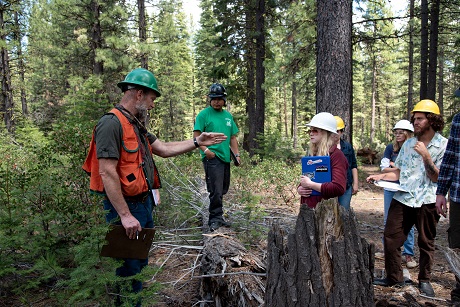Forests, Fires and Futures
In COCC’s Forest Resources Technology program, students discover a full scope of forest management skills and practices
Central Oregon’s summertime skies can shift from clear blue to smoke-choked gray in
a flash. Whether human-triggered or caused by lightning, wildfires are a seasonal
reality in the region, with “megafires” seemingly becoming the new norm in the West.
But shoulder-season prescribed burns, along with thinning of forest lands, are helping
mitigate these all-consuming burns. It’s happening regularly on local forests—even
on a small scale.
“They’ve burned twice in Shevlin Park, which wouldn’t have happened 10 years ago,”
Ron Boldenow, Ph.D., professor of Forest Resources Technology at Central Oregon Community
College (COCC), explained from his Bend campus office on a sunny, blue-sky afternoon,
where ponderosa and lodgepole pine filled the view out his window. “We’re seeing some
acceptance of that.”
In fact, controlled burns, on a wider level, are being viewed as a more common—and
essential—practice. “Brooks Resources burned before building the Tree Farm (development),”
added Boldenow. “Private people are starting to say, ‘This is a way we can get a handle
on this.’ I think we’re seeing a collaborative process working in many ways, but still
not to the point of where we want to be in managing forests.”
Getting to that point will take policies and public perception that fully embrace
fire science—blackened trees, ashy skies and all. For students of COCC’s Forest Resources Technology program, that science is just a piece of the learning process as they train to become tomorrow’s
forest technicians and managers.
Students can earn six different certificates or one of several degrees, including an Associate of Applied Science degree that preps them for transfer to a four-year university. The training, while mostly configured around labs and fieldtrips, also plugs students into the workplace.
And it’s a specialized education: COCC’s is one of only two associate degree programs in Oregon accredited by the Society of American Foresters, and just one of eight accredited programs west of the Mississippi.
“We have a requirement, a co-op work experience, that requires students to go out
and get 300 hours of work, the equivalent of a summer,” explained Michael Fisher,
Ph.D., instructional dean at COCC. “Generally speaking, that’s built around the concept
of people going to work for the Forest Service, the primary employer of our folks.”
Students, through fighting fire or other forest-based job, fulfill this part of the
program during their first summer.
For Jamie Mason, who had a summer position giving interpretive talks with “Discover
Your Forest,” a nonprofit education partner with the Deschutes and Ochoco National
Forests, the field feels wide open. “I remember being in my senior year of high school
and being completely overwhelmed by the forestry courses listed, thinking that I would
be getting way in over my head,” Mason said. “My first forestry-related class was
the ‘Mammals of Oregon’ class, and it made for a very exciting beginning to my schooling…it
really cemented me on the route I was taking in school. I’ve always enjoyed teaching
people things. The ultimate goal is to get on full-time regular with the Forest Service…or
even National Parks…or State Parks. As long as I’m outside.”
Being outside is something that calls many into the career path. And workplace opportunities
extend beyond federal jobs, in both the public and private sectors. Graduates have
landed in places like the Sunriver Nature Center, the Oregon Department of Forestry,
and the Confederated Tribes of Warm Springs, among other employers. “We have quite
a few that work for the Tribes,” said Boldenow. “Some of our top students recently
have been Native Americans.”
Lately, the diverse program has seen more women and veterans enrolling. Students discover
a supportive and top-tier program with small classes and ample opportunities to be
involved in things like state forestry conferences.
The Bend Park and Recreation District announced in July it will again initiate a prescribed
burn at Shevlin Park sometime this fall within the picturesque 1,000-acre treed valley.
It’s a place where COCC often takes its forestry students on fieldtrips, to learn
firsthand about forest health. Hardhats on and clipboards in hand, they’ll be walking
amid a charred-bark environment, hiking through the woods and stepping ever closer
to actualizing important, engaging careers in the field of forestry.
For more details on the Forest Resources Technology program, call 541-383-7700.
By Mark Russell Johnson, COCC College Relations

